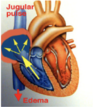Equine Cardiac Auscultation: When is a Murmur Significant? Flashcards
(73 cards)
what are the 3 causes of murmurs
- regurgitation
- increase in velocity of flow
- decrease in blood viscosity
what are the things you need to consider when looking at a murmur (6)
- intensity
- timing
- frequency
- topographic location
- shape
- radiation
what a systolic murmur
begins with or after S1 and ends before/with S2
lusssshhh-dup
what is a diastolic murmur
begins with or after S2 and ends with or just before S1 of next cycle
lub-dup-psssshh
what are the grades of murmurs
grade I: soft, audible after careful auscultation
grade II: faint but clearly audible
grade III: equivalent intensity to S1 and S2
grade IV: increased intensity but no palpable thrill
grade V: palpable thrill
grade VI: audible anywhere on body with detectable thrill
what are the murmur shapes

what are nonpathological murmurs
functional murmurs without organic heart disease
what are systolic functional murmurs
usually < grade III early to mid-systolic
common in young fit/excited horses
common in neonates
accompany colic/colitis/endotoxemia
what are diastolic functional murmurs
low grade presystolic or early diastolic murmur
lub-dub-sh
very short
what are metabolic murmurs
- increased turbulence of bloodflow due to decreased viscosity (anemia, babesia, severe thrombocytopenia)
- altered hemodynamics
- altered peripheral resistance (colic, endotoxemia)
what are systolic pathological murmurs
- tricuspid valve regurgitation
- mitral insufficiency
- ventricular septal defect
- acute onset following rupture of chordae tendinae
what are pathological diastolic murmurs
aortic insufficiency
what are the most common valve regurgitation
- tricuspid
- mitral
- aortic
- pulmonic
where is the point of maximal intensity (PMI) of mitral insufficiency
on the left side
with dorsal radiation
can you still hear S1 and S2 in mitral insufficiency
yes if below grade III
what type of murmur sound is a mitral insufficiency
plateau
what might be audible in mitral insufficiency
buzzing if there is vibration of the valve leaflets caused by rupture of chordae tendineae
what is the significance of mitral insufficiency if it is quite and localized
unlikely to be relevent in near future but may deteriorate over months/years
what is the significance of mitral insufficiency if its > grade 3 or if there is widespread radiation
advise against purchase for athletic use unless echo shows no volume overload
if echo shows no abnormality consider rate of progression and discuss
what is the prognosis of mitral insufficiency if there is exercise intolerance
guarded if there is exercise intolerance or FS % < 30%
what can significant mitral insufficiency lead to
left atrial dilation and pulmonary hypertension
atrial fibrillation may be sequel to atrial enlargement with resulting exercise intolerance
what does M-mode ultrasound of the heart show
- can measure the % fractional shortening
- measure the ventrical internal diameter during diastole and systole
where is the PMI for tricuspid insufficiency
on right side in the tricuspid valve area with dorsocaudal radiation
what type of murmur sound is tricuspid insufficiency
plateua systolic murmur




